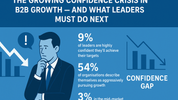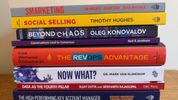When I look out over LinkedIn, you see people posting content.
- Content maybe a brochure, which we all know will say “buy my product because we are great”.
- Or content might be the amazing event or SKO (sales kick off) you have been to.
- Or content might be the award you have just won.
- Or content might be sharing an infographic of advice.
If content was an inbound play, then people would be reading this stuff and calling you up and giving you their credit card number, saying “just take my money”.
This is the dream the Hubspot sells.
But people don't ring you up and ask to buy.
I was on a call with Linkedin last week where one of Linkedin's other guests said “I've been posting for 2 years and nothing has happened”. Exactly.
Let's remind us, that content is there for two reasons
- Affirm your subject matter expertise or we could call it a brand
- Start conversations, ideally on your content as engagement
Any like or comment on your content is after all, a digital resonance with you. (But that's a blog for another day.)
Let's be honest here about LinkedIn and what happens when you post content.
Probably only 5% of your network on LinkedIn will see your content.
Again the chances of anybody calling you up after a post and buying is slim.
This is where, I would argue that content is an outbound play not an inbound play.
What you need to be doing is using content as part of your sales kit bag.
For example, you could use your content as part of any outbound play. Say your ICP is in sales enablement, you could contact a connection or even connect to a prospect and say
“I see your in sales enablement and working on XYZ, I wrote a post and would be interested in your take?”
(Let's not forget that the first thing people do when you connect them is they look at your profile and this will jump to a conclusion about what you stand for based on your profile and the content you have been posting. Another post for another day.)
If you do this and use content as an outbound play, 3 things will happen.
- They will ignore it - But they are probably not seeing your content anyway.
- They will disconnect with you - They won't buy from you anyway so you qualified them out.
- It sparks a conversation and conversations creates a sale.
Now, there are a whole bunch of assumptions in here, but I wanted to write about this simply.
One final point.
When gurus out there are telling you to post every day, they don't tell you what to post, when to post and how to post.
I went on a podcast last year, and when I asked the guy why he was running a podcast, he had been told. “If you do a podcast every day for a year, you will be a millionaire”. He did do a podcast every day and he isn't a millionaire.
That's because content is referred to as a inbound play, it's not.
Content is an outbound play.
If you're reading this and thinking, “if content is an outbound play, that means content shouldn't be in marketing it belongs in sales …… you might just be onto something.”
Thank you to Rob Durant for being the inspiration for this blog.
Let's look at some context about social media today
Linkedin is the world's biggest network site.
So let's take a step back for a moment. How about if I could pick you up tomorrow and I drive you to a place which is full of your prospects? All you have to do is grab a coffee or a tea and go up and talk to them. You can stay as long as you like.
Now, you wouldn't walk up to these prospects of yours and pitch to them. You would have a conversation. Maybe ask then how far they drove to get there? Had they been caught up in the traffic? You would have a conversation. You wouldn't pitch to them, in fact they will probably ask you at some point, “what do you do?" but more on that in a bit.
Let's look at the data, cold calling vs our social selling benchmark
Here at DLA Ignite, we are always wanting to push forward the boundaries of sales, so we decided to put cold calling head to head with the DLA Ignite methodology for social selling and create a benchmark on 1st January 2023 (and business case) for our version of social selling.
So we took a team of "cold callers" cross trained them in our methodology for social selling and here are the results.
It's worth shouting out the team, Alex, Jordan and Jensen and they work for a company called Supero.
Don't believe me? Please check the team out on social and ask them about the results!
The results with cold calling
When the team were cold calling, that is, before we trained them on social selling. I'm not sure what results you get with cold calling but they did whatever they could in terms of warming up the calls with emails or webinars, etc. And the results, they got about 2 calls a week.
As with any cold call, your job is to take the call to a next action, which might be a demo, discovery call and they averaged 0.3 of these calls.
Anyway, you will have your own figures for cold calling in your business and you will know what they are.
The results for social selling
What is social selling?
The DLA Ignite definition of social selling is
"Using your presence and behaviour on social media, to build influence make connections, grow relationships and trust. Which leads to conversation and commercial interaction".
(Please note these figures are for the DLA Ignite methodology, we cannot speak for other suppliers, please check with them, before signing any contracts.)
I need to say, before I get any comments.
There is no spam and no automation in the DLA Ignite social selling methodology!
The DLA Ignite social selling methodology does not use connect and pitch!
The DLA Ignite social selling methodology does NOT use inmails, which are spam.
In fact the program is now back and certified by the Institute of sales professionals (ISP), the only such methodology backed by a sales professional body.
Let's get onto those results for DLA Ignite methodology of social selling
The team are getting a 9% response (on average) to social selling cold outreach, so for every 100 people they ask for a call, 9 say "yes".
This figure is an average, so we think somebody with intermediate skills or an expert should be getting a higher figure should be getting a larger response. In fact, our benchmark for an expert is 13%, but I want to keep figures realistic and conservative.
As we mentioned above, with every "call" based on cold outreach, there has to be some sort of next action. For your own company, you will know what your next action is, it will be a demo, a discovery call or something.
We have found that with DLA Ignite social selling methodology 9% of the people (on average) that agreed to a call, 33.6% are converting to a next action.
This is exponential growth when compared to cold calling.
Each salesperson is averaging 10 calls / meetings per week, the good ones are getting 25 meetings a week.
Just think if you scaled that across your sales organization!
(The most successful SDR complains he has got too many meetings, which think is a great problem to have!)
Just think about that being rolled out across your sales team(s).
It's time to work smarter not harder.
Let's look at this with a business case
Let's take a sales team of 10.
We know that the average person can grow their network by 3,000 people a year. Let's assume of these 50% are going to buy, this gives you a network growth of 1,500 per person per year.
If you have 10 salespeople that gives you a total addressable market (TAM) of 15,000 new people to have conversations with.
With our, Institute of sales professionals (ISP) backed, DLA Ignite social selling methodology, (note: we cannot vouch for anybody else) based on our measured benchmark, you should be able to get, on average, meetings with 9% of this TAM of 15,000. This means your sales team can have 1350 new conversations every year.
(As we know, conversations create sales.)
As we discussed above, with any cold outreach the objective is to get a next action and using our social selling methodology and using our measured benchmark we can get 33.6% of 9% of our TAM to a next action, which is 454.
Let assume you win 1 in 3, that's 151 new sales a year using social selling, average order value (AOV) $100,000, that's
$15,120,000 = $15 million
That's an additional $15 million that you are missing by cold calling rather than social selling.
or $1,26 million you miss every month you delay moving from cold calling to social selling.
Of course, if you have more than 10 sales people, you can scale the figures up.
Imagine you are at a conversation and. the day before the event, there is a drinks in the evening, you have a call and so you are late by 30 minutes. As you enter the bar, you see all of the conference delegates and you realise they are all your ICP (ideal customer profile). You also see that each ICP is talking with, and laughing with a salesperson. Now is that salesperson they are laughing with, your salesperson or is it the competitions?
That is going on out on social media, day in and day out and if your ICPs are laughing and talking with your sales people, will be if you have trained and coached your salespeople in a sales methodology.
Want to know more about social selling, check out my new book
"social selling techniques to influence buyers and changemakers - 2nd edition".
In this brand new edition, I have updated all the text, I have also got 15 practitioners, so people who are doing this already to explain how they are get (practical) business benefit. From the CEO that has been running a digital business for over 18 months to sales leaders who use social selling every day.
Articles on how these business have and are implementing digital, from Mercer, Telstra Purple, Ring Central, Cyberhawk, Namos, Ericsson, DLA Ignite and more.
What does Mark Schaefer, Marketing guru think of the book "social selling - techniques to influence buyers and changemakers - 2nd edition"? watch the video here
It's available on Amazon worldwide. Link to Amazon.com here and Amazon.co.uk here.

 unknownx500
unknownx500











